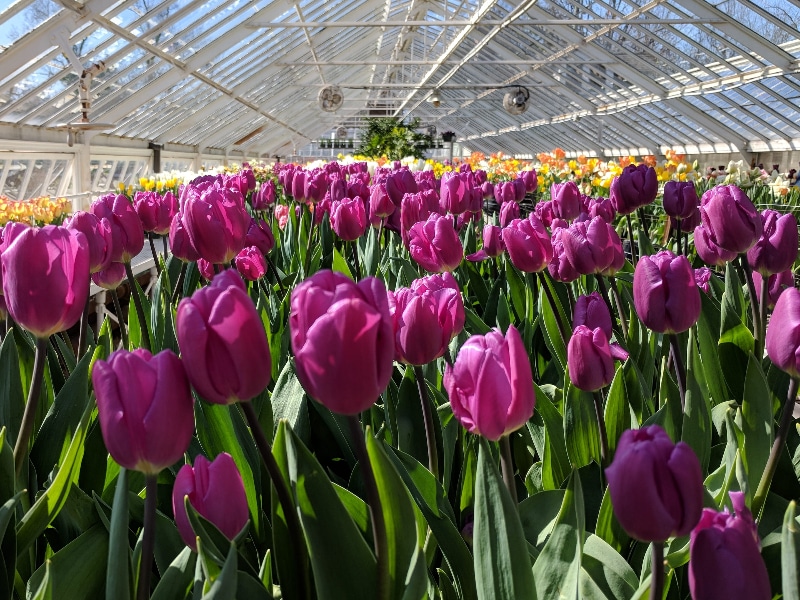In general, learning how to care for hydroponic tulips is as simple as being diligent with the methods from start to finish. That’s it, and there are no secret practices that you must discover. The key to caring for hydroponic tulips successfully is ensuring that you have no shortcomings at any point in their growth.
Those interested in growing tulips can consider the combination of hydroponics and greenhouses and take advantage of fast production. While it can be intimidating to venture out of the traditional method of cultivating tulips, you’d be surprised how simple hydroponics’ concept is. Below are the three steps to care for hydroponic tulips successfully.

How To Care For Hydroponic Tulips Comprehensive Guide
Step #1. Finishing dormancy
You start by placing tulip bulbs upright in water trays suitable for the hydroponic forcing of tulips. Place these trays in a room around 46.4°F because keeping them in a room at this temperature will help finish their dormancy period. The tray, placement of the bulbs, and room temperature are all crucial for your hydroponic tulips’ success.
Another DIY-friendly way that you can do to start and care for hydroponic tulips at home is by using a paper bag and your refrigerator instead of trays and a cold room. Place the bulbs in a paper bag and into the fridge for 13 weeks, and this should finish their dormancy period as well.
You might also find hydroponic tulip packages in the market, where all you have to do is force them to bloom yourself. With this package, you’ll add water to the container so that the bulb’s bottom gets wet to encourage establishment. You can choose from different cultivars, and the duration of waiting time for the tulips to bloom can also depend on the temperature and prior cold treatment.
Step #2. Rooting bulbs
You want to add water to the trays and store them between 37.4 to 41°F for three weeks to encourage rooting. Experienced hydroponic growers wait for an inch and a half of root growth as this length is enough to absorb water and calcium nitrate to encourage development further. What about those who want to root bulbs without trays?
You can use a vase and fill it with 2 inches of pebbles before placing the bulb over them. You will then add an inch of water to provide moisture and encourage rooting. Place the vase in a cool and dark area for around six weeks and make sure to change the water weekly.
Step #3. Grow in the greenhouse
Much like growing strawberries hydroponically, caring for hydroponic tulips will be much easier if you have a greenhouse. Remember that the greenhouse will provide the ideal environment for the tulips as they establish themselves. Overall, the environmental control you have in the greenhouse will always be advantageous, regardless of whether you’re growing traditionally or hydroponically.
Once your tulips have rooted, you will place them in the greenhouse with temperatures between 69.8 to 60.8°F, which you’ll adjust accordingly as your plants grow. It’s also essential to maintain cleanliness and moisture to help your tulips develop further. On the other hand, those who rooted tulips in a vase can place the rooted plant in a bright room but out of direct sunlight.
The ideal temperature for the vase tulip is around 60 to 65°F. Be sure to check that the roots are always in the water. And lastly, be diligent in replacing the water as well to prevent diseases.
Hydroponic Tulip Aftercare
As you have read earlier, caring for hydroponic tulip is a practice you do from start to finish. However, another popular hydroponic tulip that you can buy in the market is from Bloomaker. For these tulips, you want to remove the dead flower after it finished flowering from the stem.
Let the foliage dry completely, but maintain the water level to encourage new bulbs to develop. You can then cut the dead foliage and leave the roots. You can store the new bulbs for transplanting later on.
And according to Bloomaket, it’s also possible to regrow tulip bulbs in water.
Why Grow Tulips Hydroponically?
Growing tulips hydroponically, much like other hydroponically grown plants, is advantageous because it is a relatively hygienic process. You are not using soil, so you’ll end up with clean flowers. More so, those who are limited to space can grow tulips in containers, and as mentioned earlier, after the hydroponic tulips bloom, they will create new bulbs that you can plant again.
From a production standpoint, growing tulips hydroponically is also faster. There is even an increasing demand in the market for hydroponic tulip packages. More and more homeowners are getting interested in blooming the tulips themselves with the premise of only using water and a controlled environment.
Conclusion
Gone are the days where you can’t have crops and flowers if you also have no ground to grow them. Nowadays, even tulips can grow without soil, but it’s also essential to learn how to care for hydroponic tulips to make the most of this innovation. In general, there are no specific tricks to care for hydroponic tulips.
Instead, you must ensure that they are in a sterilized and controlled environment from start to finish. This includes using clean and proper containers and water and a room that you can maintain cold temperatures. After your hydroponic tulips develop roots, you can care for them and encourage further development in the greenhouse.
